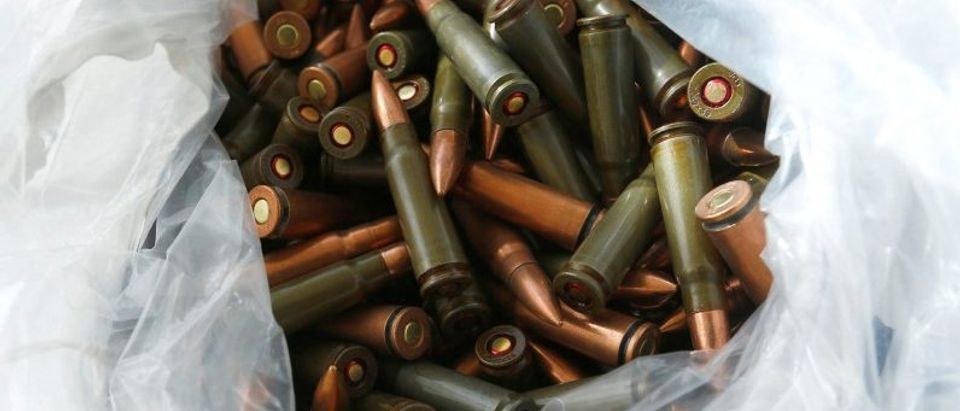By Sam Hoober, Alien Gear Holsters
To shoot at a lower price point, a lot of people use steel case ammunition, which is cheaper than brass. While some domestic producers exist, a lot of it is imported surplus ammunition either from Russia or a former Soviet bloc country.
Popular brands include the “zoo animals” as they’re often called, including Wolf and Bear, as well as TulAmmo and Barnaul.
Again, there are some domestic ammunition companies that make it as well, including Winchester and Blazer.
Typical prices before the pandemic usually were something on the order of $1 to $2 cheaper per 50 round box, with steeper discounts for bulk orders of 500 rounds or more.
However, the commonly mentioned caveat is that it “hurts your gun.”
The story goes that corrosive primer powders will eat the insides of your gun, and the projectile will wear out the throat and rifling due to being made of a harder material than typical copper-jacketed lead bullets.
Is it true? Should you stay away from steel cased ammo? Will it damage your gun? Or is it, like so much else within the gun community, a whole lot of hogwash?
Let us try to examine some evidence.
It is true at face value that if a piece of metal is rubbed against another piece of metal without a lubricating barrier, it will shave a bit off, especially if one bit of metal is harder than the other.
It is also true that older ComBloc ammunition had corrosive primer powders, and occasionally it is still found on the market.
However, the world has moved on a bit.
First, modern ammunition is no longer made with the corrosive primer powder; you have to actually work quite hard to find it with any sort of regularity.
Typical steel-cased ammunition has a polyurethane or polyurethane-like coating on the steel case itself. The typical projectile is a bi-metal bullet, featuring a steel jacket covering a lead core, with a copper wash over the steel jacket to coat it.
So, steps are taken to ensure that steel doesn’t touch the chamber, the throat or the rifling.
Furthermore, chrome-plated tool steel is actually harder than the bi-metal jacket of the bullet; chromium on its own is harder than steel (about 9 on the Rockwell C scale; most steels are between 5 to 8) and roughly three times harder than copper.
If any erosion occurs, it’s likely more related to heat (ie shooting A LOT of bullets) than the bullets themselves.
Smart people in the comments section will quickly point out what Lucky Gunner Labs found.
Several years ago, Lucky Gunner Labs conducted an epic torture test using four brand-new and identical Bushmaster AR-15 carbines to compare the effects of shooting brass vs steel case ammunition.
One gun was selected for a particular brand of ammunition, so one rifle was only fed with Federal brass-cased FMJ, one was fed Brown Bear steel case, one received Wolf steel case and one was only fed Tula steel case.
All were using standard 55-grain (M193) ball.
Over the course of 10,000 rounds fired over several days (extended shooting sessions) the guns shooting steel case ammunition exhibited bullets tumbling and lower muzzle velocities after about 6,000 rounds, whereas the rifle shooting Federal brass was running as new.
When the barrels were cut open and examined, they found the bi-metal coating basically didn’t do anything; the chrome lining of the barrels was gone, as was most of the rifling. Shooting steel case ammo in that instance had completely eroded the bore.
However, here comes the issue:
Lucky Gunner Labs admitted readily that their tests were flawed; they “shot the guns until they were hot, and then kept shooting them,” meaning they put the guns on a firing schedule that would accelerate wear on the barrel and gas system.
There are some purported other tests that have been bandied about, such as a series of tests run by the former Frankford Arsenal in the 1940s, that found bi-metal ammunition (it’s been around quite some time) had no ill effects compared to brass. A supposed joint test between Federal and Tula found something similar. However, I wasn’t able to find any corroboration that these tests ever took place.
It should also be noted that those were Bushmaster rifles.
While not bad guns by any means, it’s still a poverty pony (I like Karl Kasarda’s term “M-Forgery”) and chrome-lined barrels that are made cheap are not necessarily going to have as thick a lining or as uniform a lining – or be lined with as much chromium overall – as one that is not made cheaply.
In other words, not all barrels that meet the same description are necessarily created equal.
It should also be noted that the AR-15 platform in particular is noted for suffering more ill effects from use of bi-metal jacketed ammunition than other platforms. Other military rifle platforms, such as the FAL, the HK91/G3/CETME family, and certainly the AK family are not.
Likewise, there is little evidence that the barrels of handguns are worn out faster by use of steel ammunition.
If anything, steel-case ammunition would be safer to use in a pistol given the lower chamber pressures of pistol cartridges, which typically average less than 40,000 psi. The typical rifle cartridge generates anywhere from 50,000 to 60,000 psi.
So, when people say steel ammunition damages your gun it’s more that it depends on the gun, how you use it, and how well it’s made. A poverty pony/M-Forgery? Is probably going to wear pretty fast. Your Glock or AK-47? Not so much.
Click here to get your 1911 Pistol Shopping Guide.
Click here to get The Complete Concealed Carry Training Guide
Sam Hoober is a Contributing Editor to AlienGearHolsters.com, a subsidiary of Hayden, ID, based Tedder Industries, where he writes about gun accessories, gun safety, open and concealed carry tips. Click here to visit aliengearholsters.com.


